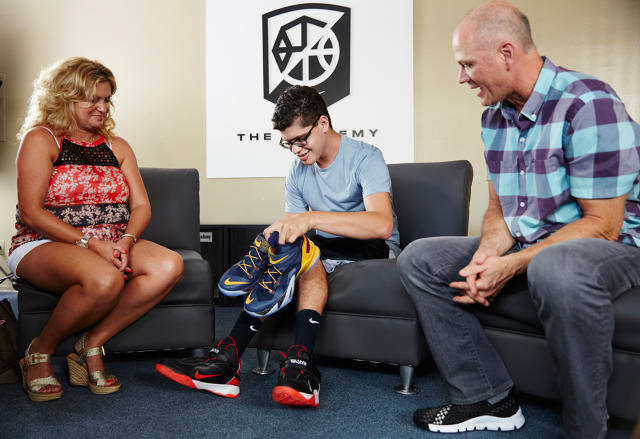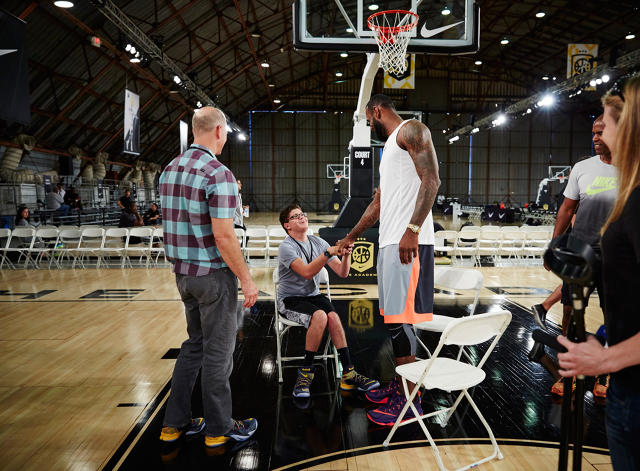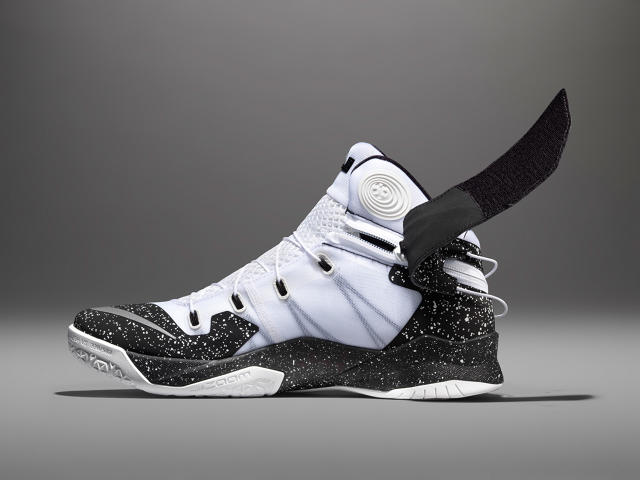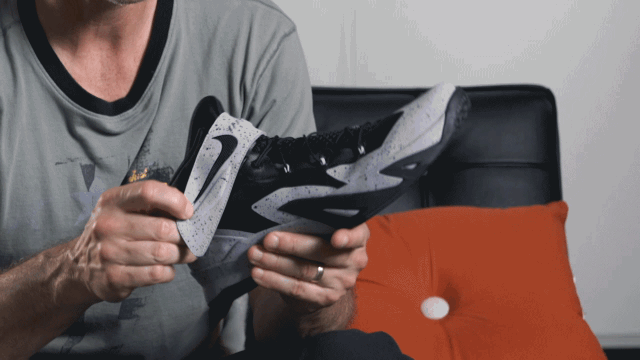With Flyease, Nike Reinvents The Zipper
Nike-tested. Teen-approved. Flyease lets you peel open a shoe with one hand.
Nike’s Zoom Soldier 8 is built with accessibility in mind. Its Flyease system solves a problem for amputees, stroke victims, and people with cerebral palsy that most of us take for granted each day: tying our shoes. A subtle zipper snakes around the heel, letting you peel open or close the shoe with one hand.
“It was more than just about winning a gold metal or breaking a world record,” lead designer Tobie Hatfield says. “It was literally about quality of life.” Flyease is also a quicker way for anyone to squeeze in and out of hightops—especially handy in places like airport security.

Flyease development started seven years ago, when Nike Sr. Director of Athlete Innovation, Tobie Hatfield—the younger brother of famed Nike designer Tinker Hatfield—received a special request from CEO Mark Parker. Jeff Johnson, who had been Nike’s first employee, had a stroke, and lost the ability to articulate his right hand. Tying a shoe was no longer possible.
But being a friend of Nike has its benefits. Hatfield improvised a temporary solution: a shoe with two pieces of hinged velcro, one that wrapped around the instep, and one that wrapped around the heel. It didn’t have the stability an athlete would require of a shoe, but it was good enough for Johnson to wear during his recovery.
The idea went dormant. In the interim, Hatfield would develop a shoe-mounting system that could fit onto Ossur’s carbon fiber Cheetah feet—the performance prosthetic used by Paralympic athletes—and pioneer Nike’s massively successful flexible sole platform, the Nike Free.

Then around the 2012 London Olympics, Parker tapped Hatfield again. This time, Parker read a blog post from a 16-year-old Miami native, Matthew Walzer. Despite living with cerebral palsy, he was a sneakerhead and Nike fanatic who tells me that he discovered hightops as a more comfortable way to stabilize his ankles than orthopedic braces, which left blisters on his legs and feet. But he still had no way to tie his own shoes.
“I kind of dealt with it through elementary and middle school,” Walzer recounts. “I thought ‘Okay, mom and dad will tie my shoes and this isn’t a big deal. Once I got to high school, though, I was 15, 16. Not only was it frustrating, it was embarrassing.”
“[Parker] said, ‘Maybe we can help Matthew out,'” Hatfield explains. “I said certainly.” The Hatfeld and Walzer began meeting on Skype. Hatfield found Walzer to be incredibly articulate, but pushed him to paint a better picture of life in hightops. Turned out, tying his shoes was just part of the problem. Fitting his foot inside, which was often too stiff to turn that tricky bend through the heel to the sole, was just as problematic. “It’s easier for them to come in from the rear and really land their foot like a plane onto the runway,” Hatfield says. “But you have to have a runway that’s accessible, easy to see.”
With this data in hand, Hatfield returned to his earlier experiments. He wanted the design to exist as a real shoe that any athlete could use (which meant that he had to toss the old velcro heel idea). He eventually circled back with Nike’s product teams to see who might have room in their line to test drive some new technology. Over the course of three years, Hatfield sent Walzer samples every few months, video chatting to see how they were working, and iterating again.
The result became Flyease. Hatfield summarizes it as a “cutting-edge wrap-around zipper system.” It’s a very elegant way to unzip the heel with one hand, slip your foot in, then zip it back up—no tying required.

Of course, the engineering inside the final product is a lot more complicated. The zipper isn’t any old zipper. It’s been built to work around a curve, a challenge that required Hatfield to tap the expertise of Nike’s apparel team. The zipper itself connects to a velcro strap that seals the top of the shoe. But you don’t need to yank hard on this strap to zip and unzip it. Rather, once the velcro has been undone, you can grab the top of the heel and unpeel it like an orange. The orange peel is Hatfield’s metaphor, but trying it out for myself, I know exactly what he means. I’m impressed by the satisfying and sturdy level or resistance—what almost feels like a stiff wetsuit that unhinges to transform the hightop into a clog.
Meanwhile, the shoe’s upper tightens and loosens in tandem with the zipper system. How? A tunneling system filled with internal cords wraps from the heel all the way around the shoe’s upper to sit on top of the instep, where they resemble laces. Getting the cord length just right was one of the biggest challenges in building the shoe. Hatfield says it took iteration after iteration after iteration, in which he tested the technology with 30 different basketball players on Nike’s own courts. Even now, as it launches, Flyease is still considered a work in progress.

“It’s still not perfect by any means,” Hatfield says. (I noticed, for instance, that if you unzip the backs all the way, the zipper tends to catch just a bit near the end of its run.) “Sometimes with technology we can design and continue to iterate and tweak until the cows come home, but most of the time, where we’re gonna do our best learning is if we’re 75%, 80%, or 90% there, and then it’s good to get in the game. I think that’s where we’re at. We know we can continue to make improvements, but we wanted to give access to those who need this sooner than later.”
Flyease might appeal to sneaker fiends who don’t technically need it, too, just because it’s an easier way to put on a shoe. I couldn’t squeeze into the preproduction size nines Nike sent me to test the mechanism, but Hatfield swears by the Flyease for making one’s way through airport security, and has already built a Flyease running shoe for his personal use to prove the concept. And, yes, an official version of that is on its way. (Some day.)
When I ask Walzer what it’s like to have his own shoe created by Nike, he quickly corrects me: “It’s not just my own shoe. This is going to help so many people. I’m proud,” he says. “And it’s not just for the disabled community. The great thing about this shoe is whether you’re able body, disabled, have cerebral palsy or Parkinson’s, anyone can wear this shoe and do anything with it.”
Fast Company , Read Full Story
(85)



